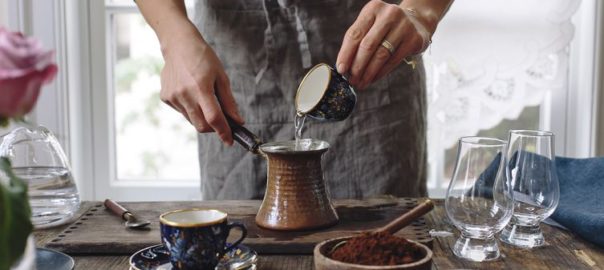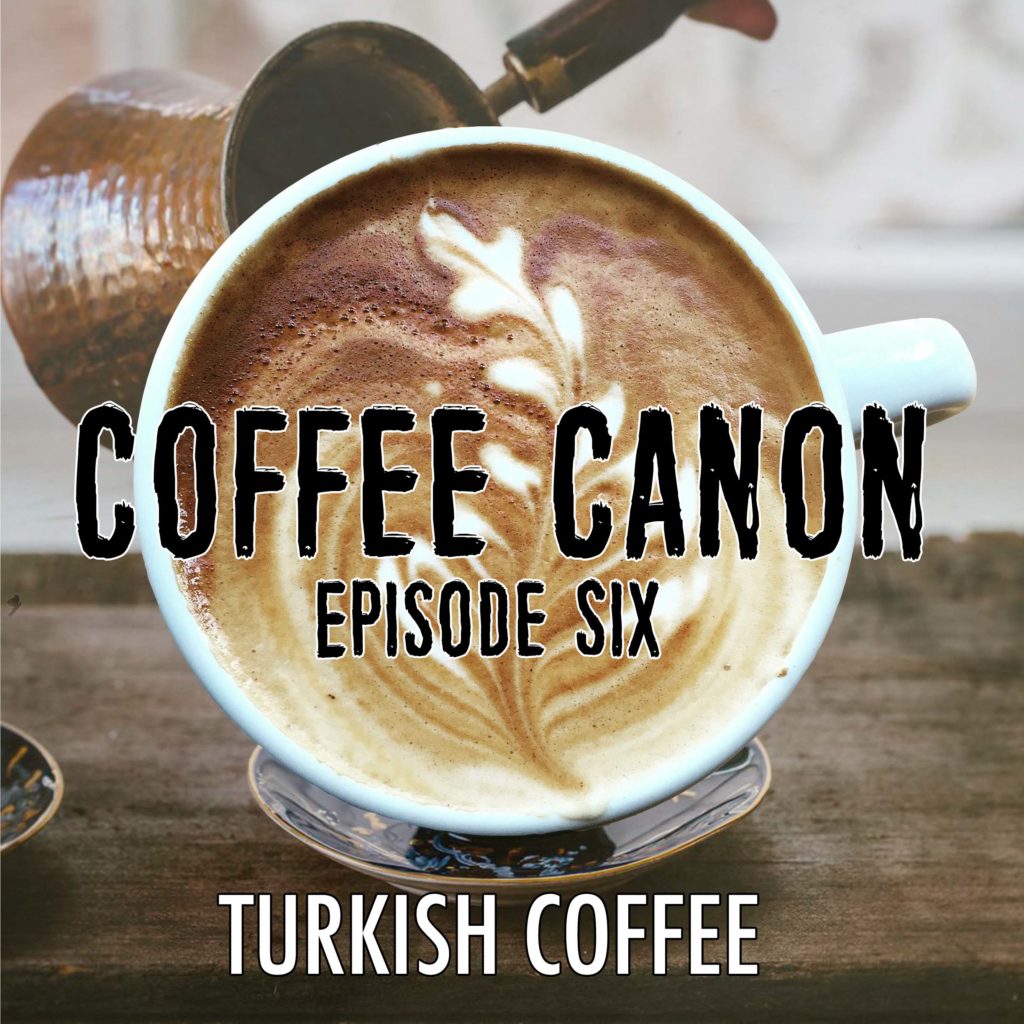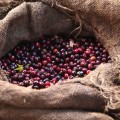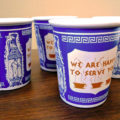From the halls of Sultan Suleiman the Magnificent to the streets of the Grand Bazaar, from the fields of Kaldi the Goat Herder to the room of an Israeli fortune teller; Turkish Coffee runs the gambit. It’s the world’s oldest brewing technique – surviving military coups, government bans, and industry monopolies. It’s unfiltered, strong, and unlike anything else you’ve ever tasted. It has survived the test of time, both served to royalty with panache, and served to commoners streetside.
Episode Six Sources:
- Wikipedia:
- Turkish Coffee: https://en.wikipedia.org/wiki/Turkish_coffee
- Tasseography: https://en.wikipedia.org/wiki/Tasseography
- History of Coffee: https://en.wikipedia.org/wiki/History_of_coffee
- Pieter van den Broecke: https://en.wikipedia.org/wiki/Pieter_van_den_Broecke
- “Coffee grounds brewed trouble for Israeli fortuneteller,” McClatchy Newspapers, by Dion Nissenbaum http://www.mcclatchydc.com/news/nation-world/world/article24466912.html
- “Fortune Teller Held for ‘Cancer’ Fraud: https://www.haaretz.com/1.5056803
- All about the Turkish Coffee Pot: http://www.turkishstylegroundcoffee.com/turkish-coffee-utensils/turkish-coffee-pot/
- “Turkish Coffee: A Story of Mystery, War, Romance & Empire,” Perfect Daily Grind, by P. Dobrenov: https://www.perfectdailygrind.com/2015/09/turkish-coffee-a-story-of-mystery-war-romance-empire/
- “Don’t Call It ‘Turkish’ Coffee, Unless, Of Course, It Is,” NPR by Joanna Kakissis https://www.npr.org/sections/thesalt/2013/04/27/179270924/dont-call-it-turkish-coffee-unless-of-course-it-is
- Story of Kaldi the Goat Herder: http://www.ncausa.org/About-Coffee/History-of-Coffee
- “The Coffee Trail: A Muslim Beverage Exported West,” Foundation for Science Technology and Civilisation by Salah Zaimeche: http://www.muslimheritage.com/uploads/Main%20-%20Coffee.pdf
- Ukers, William H. (1935), “All About Coffee” 2nd Edition; The Tea & Coffee Trade Journal Company, New York: https://www.amazon.com/about-Coffee-Second-William-Ukers/dp/1614270023
- “The World of Caffeine: The Science and Culture of the World’s Most Popular Drug” By Bennett Alan Weinberg, Bonnie K. Bealer https://books.google.com/books?id=Qyz5CnOaH9oC&pg=PA3&dq=coffee+goat+ethiopia+Kaldi&lr=&ei=paxHStuDJ4XuzATj97hf#v=onepage&q=coffee%20goat%20ethiopia%20Kaldi&f=false
- “Istanbul’s Historic Coffeehouses,” The Guide Istanbul by Joshua Bruce Allen: http://www.theguideistanbul.com/article/istanbuls-historic-coffeehouses
- Music:
- Podington Bear, A Gentleman – http://freemusicarchive.org
- Podington Bear, Don’t Go – http://freemusicarchive.org
- Podington Bear, 14 Rarified – http://freemusicarchive.org
Episode Six Transcript:
A big part of the difference between coffee brewing methods comes down to the filter. French press coffee is so distinct because of the metal mesh filter that keeps grinds out of your cup, but lets coffee oils into it. Espresso is similar in this regard: the nice layer of crema that great shots of espresso are known for is a result of the metal portafilter that allows these coffee oils into each shot.
Coffee brewing methods that use paper filters strive for a cleaner taste that highlights bright flavor profiles and crisp tasting notes. There’s tons of these filter cones and brewing devices on the market, but the most popular are the Hario v60, the Kalita Wave, the Bee House, the Chemex, and the AeroPress. All of these devices use paper filters, and all are seeking to bring out the best flavors of the coffee you brew in them. At the end of the day, the biggest difference between these devices is the type of paper used for the filter. Coffee brewed in a Chemex doesn’t taste unique because of the shape of the Chemex or the glass cone – it tastes unique because of the heavier paper filter that Chemex makes specifically for their coffee device.
See, every coffee brewer has a different shape and physical aesthetic, but when you get right down to it, the single biggest factor that’s going to alter the taste of your coffee, aside from grind consistency, is the type of filter used.
So what happens when you brew coffee without a filter?
I’m Colin Mansfield, and welcome to Coffee Canon.
The most popular filter-less coffee brewing method is called Turkish Coffee. It’s brewed in a device called a Cezve (Jezz-ve or Chez-ve) spelled c-e-z-v-e – basically it’s a small pot on the end of a long handle. These can be super simple and functional, or incredibly ornate for fancy occasions.
Brewing Turkish Coffee is about as easy as it gets – you grind coffee very fine, to almost the consistency of a powder. Put the coffee in the Cezve, then add water. Next, put your Cezve over a heat source. The point isn’t to get the water to boil right away, but to gradually heat it until the coffee begins to froth. Once that happens, your Turkish Coffee is ready to serve. Simply pour your mixture into small cups or shot glasses.
As you can probably imagine, there is a large amount of sediment in the final product. When drinking Turkish Coffee, you’ll want to stop after consuming about 2/3 of the cup. The last 1/3 to 1/4 will typically be composed of coffee grinds that have settled to the bottom. And that’s the other thing – don’t drink your cup of Turkish Coffee right after it’s served. Let it sit for a few moments to allow the grinds to settle at the bottom. Otherwise you’ll probably have to floss after drinking your cup.
Many restaurants that serve Turkish Coffee will offer both sweetened and unsweetened versions. The sweetened versions that I’ve tried both here in the US and in the Middle East are no joke – sweet, means sweet.
The cool thing about Turkish Coffee is that there’s almost nothing standing in the way of you tasting the bean. There’s no paper filter to block oils, and there’s no metal mesh to block grounds. It’s all there – for better, or worse. The coffee is, of course, very strong and very caffeinated – think something closer to a shot of espresso rather than a sip of filter coffee.
The origins of Turkish Coffee are closely tied to the origins of the coffee beverage itself – it was, perhaps, the very first way coffee was brewed. And so, like with all things on this podcast, we have to go back. Before coffee made its way to Turkey, it was a valuable source of income in Yemen. And before Yemen, it was a wild plant on the Ethiopian Plateau.
The “who” and “when” of coffee’s discovery is steeped in legend – pun completely intended. Most sources I found point to the 10th century as the “when” – the “who,” on the other hand, isn’t a universally agreed-upon person. There are two popular legends however, which tend to get repeated most by coffee books and papers. The authenticity of these stories is definitely suspect, and its likely that they’re more fiction than fact. But hey, who doesn’t like a good story?
The first account talks of Sheik Omar, a man who had been exiled to the Yemeni desert for certain moral remissness. Facing starvation, the Sheik and his followers scavenged the nearby plants for anything to eat. They came across small berries growing on a shrub, which, while appearing to be edible, were also incredibly bitter and hard. To improve the taste, they roasted the beans in a fire. To improve the texture, they softened them in water. Not only did the resulting brown beverage taste good, but it left Omar feeling invigorated and refreshed.
When Sheik Omar returned from exile his salvation was considered a miracle – coffee became famous, and Omar became a saint.
The second legend revolves not around a sheik, but a goat herder named Kaldi (or Khalid depending on the translation). Kaldi worked on the Ethiopian Plateau, the birthplace and original home of the coffee plant. One day Kaldi noticed that when his goats ate the fruit off of particular shrubs, they became energetic and refused to sleep. Dancing caffeinated goats made it difficult for Kaldi to do his job, and he complained about as much to the abbot of the local Muslim monastery. The abbot, seeing a possible opportunity, tried the beans for himself and – wouldn’t ya know it – he felt more alert. He ordered that the beans be crushed and steeped in water, creating a drink to share among his fellow monks. Thereafter no one at the monastery had trouble staying awake during the evening services.
According to this legend, the story of the wakeful monastery spread rapidly through the East, causing other nations to experiment with coffee. This was the beginnings of coffee culture.
While these two coffee origin stories seem to be pervasive, there are other simpler accounts: in one, a Yemeni Sufi mystic observed abnormally active birds snacking on coffee cherries and decided to try them for himself. In another, civet cats are said to have eaten coffee beans in central Africa, carried them to Eastern Africa, then pooped them out in the Ethiopian mountains. Here, the tale says, coffee trees sprouted and were discovered by a traveling Arab merchant. If you’re familiar with modern Kopi Luak coffee (otherwise referred to as cat poop coffee), this brings an entirely new historical dimension to the idea.
Regardless of which account you choose to believe, there are patterns that pop up when you lay these stories next to each other: animals almost always tend to be involved, it’s discovered through observation, nearly always on accident, and Yemeni monks tend to find their way somewhere into the story.
Also, it’s worth noting that all the stories tend to take place within a century or two of each other. When you stop and put this in perspective, it’s actually really interesting. This is a wild plant we’re talking about – not something cross-bred to cultivation perfection in a greenhouse somewhere. The coffee plant and its fruits went undiscovered for thousands of years, slipping through the fingers of the ancient Greeks, Romans, Middle-Eastern, and African worlds. Then, all of a sudden – seemingly out of nowhere, a bunch of legends about how, when, and where coffee was discovered. Still, these are legends – coffee’s rise to world industry was still hundreds of years in the making.
This great book I found called “The World of Caffeine” discusses coffee’s origin story in a really approachable way – and one section caught my eye in particular. Here, authors Bennett Weinberg and Bonnie Bealer discuss at what point coffee went from African legend to primary-document recorded fact:
“Although European and Arab historians repeat legendary African accounts or cite lost written references from as early as the sixth century, surviving documents can incontrovertibly establish coffee drinking or knowledge of the coffee tree no earlier than the middle of the fifteenth century in the Sufi monasteries of Yemen in southern Arabia.”
At this point in world history, Yemen had an important role to play: not only did it have a desirable crop, but it had an accessible trading port as well. This port was in the far southwest corner of Yemen, opening into the Red Sea. It’s name ended up becoming synonymous for quality coffee in the 15th, 16th, and 17th centuries, and while it’s no longer used as a port today, you can find its name on every Starbucks menu world-over. It’s called Mocha.
Yemen had captured lightning in a bottle – their coffee crop was booming, the money was flowing, and they had no real competition. In effect, they had a monopoly on the fledgling coffee industry. And so, as demand for their product grew, Yemen did the natural thing: they stacked the deck in their favor and cut off competition. They made it illegal to sell live coffee trees or seedlings. But, with demand for coffee rising in Europe, and supply limited to the Yemeni bottle-neck, it was only a matter of time until someone stepped in to break the monopoly. That someone turned out to be a Dutch merchant named Pieter van den Broecke. In 1614 he first tasted coffee in Mocha, and two years later he pulled a heist that forever changed the future of the coffee industry: he stole live coffea Arabica bushes, and transported them back to Amsterdam. This single act put into motion a series of events that resulted in coffee as we know it today: a billion dollar industry that is bought, sold, and traded world-round.
Backing up just slightly, in 1555 Yemen was still the world’s coffee powerhouse. The Ottoman Governor of Yemen, (and I’m probably going to butcher this pronunciation) Özdemir Pasha, absolutely loved coffee. Under his rule, a new method of brewing coffee was discovered and established: the beans were roasted over a fire, finely ground, then slowly cooked while steeped water. The Governor of Yemen shared this method with Sultan Suleiman the Magnificent, the leader of the Ottoman Empire. He loved this take on coffee and popularized it in Istanbul and beyond. Turkish Coffee had arrived.
As you might imagine, brewing coffee for the Governor of Yemen and the Sultan of the Ottoman Empire wasn’t as simple as throwing some beans in hot water; no, it was an ordeal. One article I found referenced coffee brewing ceremonies with upwards of 40 assistants needed to properly serve the drink. The brewing ritual was ornate – it included incense, Turkish Delight, and rosewater cologne. The drink itself was spiced with mastic, cardamom, and ambergris. Coffee brewing became so popular that the position of Chief Coffee Maker was added as a legitimate court position – and it was an honor. Apparently a number of Chief Coffee Makers rose through the ranks, eventually becoming Grand Viziers to the Sultan. That would be like the White House barista becoming the President’s Chief of Staff.
About 100 years later, in 1656, the Ottoman Empire pulled a 180 on coffee. Grand Vizier Koprulu helped establish laws which outlawed coffee drinking altogether. Why? Well, as with many bans, the primary reason was, in a word, fear. First, religious fear – apparently people were spending more time drinking coffee and socializing than they were worshipping. Second, political fear. The ruling class of the Ottoman Empire believed that when normal everyday citizens gathered to socialize while sipping coffee, they were more likely to question political doctrines and laws.
If you were caught drinking coffee at this time, the penalties were severe. One article I found related that the first offense would result in being beaten with a cudgel. A second offense, however, would result in being sewn into a leather bag and thrown into the nearest river. I couldn’t find any documents telling of instances where either of these things actually happened – it’s not clear if these were empty threats. But regardless, little was achieved with these new laws – coffee remained popular, and even continued to spread.
If there’s anything I’ve learned while studying coffee’s history around the world, it’s that it’s rarely present without coffeehouses or cafes. The Ottoman Empire is certainly no exception. In an interview with The Guide Istanbul, art historian Cicek Akcil said, “Different historians differ on the exact date, but we know that traders Hakem from Aleppo and Şamlı from Damascus opened Istanbul’s first coffeehouse in Tahtakale some time between 1551 and 1560…the drink didn’t begin to enter regular use in the Ottoman palace until the reign of Süleyman the Magnificent.” Despite the unsuccessful coffee ban, coffeehouses sprung up in both upper-class and lower-class neighborhoods. Akcil, the art historian, discussed this as well saying, “The first coffee houses to open in Ottoman times were based around serving their neighborhoods. Later, many kinds of coffee houses appeared, such as tradesmen’s coffee houses, janissary coffee houses, and firemen’s coffee houses. There were also opium smokers’ coffee houses and public storytellers’ coffee houses, as well as coffee houses for aşıklar — the folk poets and musicians of Turkish oral culture…Sometimes a barber would sit next to the coffee hearth so you could get a shave there as well. The janissary coffeehouses often had Greek dancers for entertainment.”
A great place to see an example of what these 16th century coffeehouses would’ve looked like is the tourist-friendly Grand Bazaar in Istanbul. It’s one of the oldest and largest covered markets in the world, with history dating back to the mid 15th century. It’s considered by many to be one of the world’s first shopping malls. Inside you’ll find a family owned and operated classic Turkish coffeehouse, founded around 1909. It’s set up in much the same way Ottoman coffeehouses would’ve been – a small room, with one side open to the street. Here, customers drink Turkish coffee or hot ginger tea while sitting on small stools and listening to the sounds of the market around them.
If you’ve ever visited Greece or an authentic Greek restaurant, you might’ve seen something called “Greek Coffee.” This actually confused me for a while, by taste I couldn’t tell the difference between Greek Coffee and Turkish Coffee. Both are made without a filter in a Cezve. Both use finely ground coffee, brought to a gradual boil, then served in a small cup – grinds and all. Well, as it turns out, they’re the same drink. And up until the mid 1970s, it was even called “Turkish Coffee” in Greece. The crux of the name change came as a result of the 1974 attempted Greek military coup on the island of Cyprus. For about 10 years, there had been ongoing turmoil between Greece and Turkey regarding who the island belonged to – but in 1974 this all came to a head. On July 20th Turkey invaded the island, and by July 23rd the ruling Greek junta collapsed. As you can probably imagine, this left a lasting impressions not only on the island of Cyprus, but on all of Greece.
Albert Arouh, a Greek food scholar, said in a 2013 interview with NPR, “The invasion sparked a lot of nationalism and anti-Turkish feelings. Some people tried to erase the Turks entirely from the coffee’s history, and re-baptized it Greek coffee. Some even took to calling it Byzantine coffee, even though it was introduced to this part of the world in the sixteenth century, long after the Byzantine Empire’s demise.” By the 1980s it was no longer politically correct to order a “Turkish coffee” in Greece, and by the 1990s brand-name coffee companies were airing TV advertisements saying things like “in the most beautiful country in the world, we drink Greek Coffee.”
Greece isn’t the only country to have adopted Turkish coffee while changing the name. The Armenian Genocide, where the Ottoman empire systematically murdered 1.5 million Armenian people between 1914 and 1923, had a similar effect on the drink’s naming conventions – there, it’s called Armenian Coffee.
Each of these versions of the drink tend to be brewed slightly differently. Whether its a cultural statement, or simply a difference in convention, I can’t say. In some iterations of the drink, smaller amounts of hot water get added to the coffee grounds initially until a thick paste forms, after which the rest of the water is added. Sometimes cold water is used, other times the grinds aren’t added until the water is already warm. If you want to try the different drinks yourself, just make sure you use the right naming convention when you order.
One of the more eccentric uses of Turkish coffee comes in the form of fortune telling. This is done in much the same way tea-leaf reading is conducted – in fact, both fall under the same brand of divination – its called tasseography, or sometimes tasseomancy or tassology. Tasse, being the French word for cup. After drinking a cup of Turkish coffee (or Greek coffee or Armenian coffee…you get the idea), the cup is sometimes swirled, then left alone for a time to allow the grinds to dry. Some traditions call for it to flipped upside down onto its saucer. In the Turkish tradition, the cup is turned towards the querent, then divided into horizontal halves; the bottom half relates messages about the past, while the top half is used to tell the future. The cup can also be divided into vertical halves for yes/no answers to specific questions.
After the reading is conducted, the querent is told to “open the heart.” At this point, they place their right thumb into the coffee grinds and rotate clockwise just slightly. This impression is read by the fortune teller to be the querent’s thoughts or emotions.
I couldn’t find a ton of stories specifically about Turkish coffee tasseography, but one did jump out. In 2007 a famous fortune teller from Israel named Sana Kuma was arrested for practicing magic – a crime punishable under Israeli law with a 5-year jail sentence. One of her clients alleged that she had cheated him out of about $1000 in exchange for fake fortunes. Kuma had been practicing tasseography for nearly 15 years at this point, and she had some fairly high-profile clients including a former Miss Israel. The Israeli law that she violated is vague at best – its okay to read Tarot cards and conduct astrology, for example. This imprecise law must have been enforced a fair amount – there’s actually an attorney out of Tel Aviv who specializes in defending accused witches.
Basically, the purpose of the law is to keep fake fortune tellers from taking advantage of people – but the only way to imprison these divinators is to prove that they know that they are fakes. Which is actually pretty difficult. In the end, Kuma was able to cut a deal with Israeli authorities – a refund to the accuser in exchange for no jail time.
The only other article I could find about Sana Kuma was a short news article from 2008 – a year later. Apparently, she had charged a woman about $150 in exchange for treating a fake brain tumor with amulets, injections, and concoctions. No word on whether she foresaw the police detaining her.
From the halls of Sultan Suleiman the Magnificent to the streets of the Grand Bazaar, from the fields of Kaldi the Goat Herder to the room of an Israeli fortune teller; this drink runs the gambit. It’s the world’s oldest brewing technique – surviving military coups, government bans, and industry monopolies. It’s Turkish coffee – unfiltered, strong, and unlike anything else you’ve ever tasted. It’s survived the test of time, both served to royalty with panache, and served to commoners streetside. It’s probably going to outlive us all, so the next time you have the opportunity – taste it. Just make sure someone’s there to tell you if you have any grounds stuck in your teeth.
I’m Colin Mansfield and thanks for listening to Coffee Canon. If you enjoyed this episode, please share it with friends by sending them this link: boisecoffee.org/coffeecanon. Also, if you haven’t already, go to that link and sign up for the Coffee Canon email list. You’ll get exclusive sneak-peaks at upcoming episodes and access to additional content. Finally, do me a solid and leave a review on Apple Podcasts. Thanks for listening, and have a great week. Go find some Turkish coffee.
Podcast: Play in new window | Download
Subscribe: Apple Podcasts | Android | Stitcher | RSS




